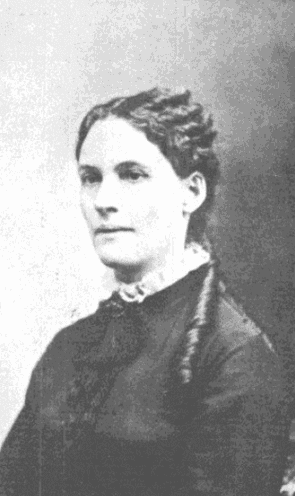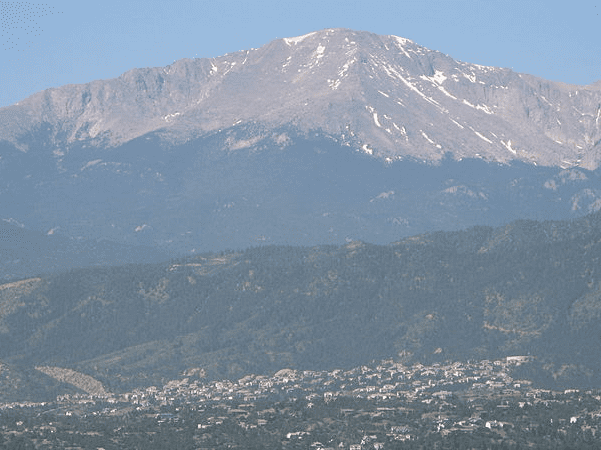Introduction: Gena Philibert-Ortega is a genealogist and author of the book “From the Family Kitchen.” In this blog post, Gena finds old newspaper articles and reads about Victorian women who bravely climbed or rode to the top of Pikes Peak in Colorado—some wearing corsets!
Climbing Pikes Peak in Colorado was quite the accomplishment for our nineteenth century ancestors. In 1806 Zebulon Pike declared that he thought the mountain was impossible to climb. At 14,115 feet it is and was no walk in the park. Temperatures can drop 30 to 40 degrees at the higher elevations, a fact that early pioneer hikers were in some cases ill-prepared for.

Fourteen years after Zebulon Pike’s prophecy, a young man named Edwin James proved that it could be climbed. And so the rest, as they say, is history.
But maybe it’s not a history that’s been completely told.
Imagine hiking the Peak in a long heavy dress and corset! If men thought the hike was difficult in the nineteenth century, it could have only been compounded by what women were expected to wear during this time period. Nonetheless, women did.
First Woman on Pike’s Peak
Fifty-two years after Zebulon Pike proclaimed no one could ascend the Peak, a woman did just that: Julia Archibald Holmes, a suffragette and abolitionist, climbed to the top of the peak accompanied by her husband in 1858.

Nearly one hundred years later, her exploit was recounted in this newspaper article.
In that letter* she wrote her mother from atop Pike’s Peak, Julia said of her historic climb:
Nearly everyone tried to discourage me from attempting it, but I believed that I should succeed; and now here I am, and I feel that I would not have missed this glorious sight for anything at all.
While not as comfortable as today’s sportswear, Julia did wear bloomers and a shorter dress that aided her in hiking more comfortably up to the mountain’s summit.
It’s not exactly spandex, but bloomers were at least an improvement for the intrepid mountain climber!
After Julia, women continued to ascend the mountain, some by hiking the trails while others used different modes of transportation.
Pikes Peak Inspires “America the Beautiful”
One of the more famous results of having reached the top of Pikes Peak and marveling at the scenery was the penning of the poem “Pikes Peak” by Katherine Lee Bates; her poem was turned into the patriotic song “America the Beautiful.” As a visiting professor at Colorado College in 1893, Bates had the opportunity to ride up to the Peak. The magnificent view from the top gave her the inspiration to write the poem.
Woman Journalist Goes to the Top
Not all the women who went to the top of Pikes Peak hiked; some, like Katharine Lee Bates, rode in wagons—or even on the backs of mules. New Orleans newspaper travel writer Catharine Cole (pen name for Martha R. Field) wrote about her journey up Pikes Peak in 1884 on a mule, led by a guide. Her report gives a sense that even with the added convenience of riding up the mountain, a woman still faced challenges with the thin air at high altitude—combined with the difficulty of breathing while wearing a corset!
Suffragettes Hoist Flag
Julia Archibald Holmes wasn’t the only suffragette who climbed the mountain. Like with any endeavor, once there is the pioneer who shows that something can be done, others soon follow. And while women continued to climb Pikes Peak for the adventure and the magnificent view, groups of women also used the mountain as a way to get their message across. In 1909 suffragettes ascended and planted a “Votes for Women” flag at the summit.
Four Generations of Women from One Family Climb the Peak
This article from a 1905 issue of the Denver Post is a family historian’s dream. It would seem that not just one female member of the family climbed the peak, but four generations of the Knapp family women—including a 4-month-old baby! By achieving this goal they disproved the adage that the Peak was “too high for the very young and the very old.” The youngest in their party, understandably, was the youngest ever to ascend the mountain, and the oldest was 85 years of age. Names, ages, and residences are provided in the article.
Pikes Peak Can Be a Dangerous Place
While many have successfully climbed to the summit of Pikes Peak, the ascent is not without risk. As hiking to the summit became popular, more and more individuals and families climbed the mountain and some tragic accidents did occur. In their eagerness to ascend the famous Colorado attraction, some downplayed the potential danger in such a trip. While today we know of difficulties that excess exercise combined with changes in altitude and weather can cause, our ancestors didn’t always consider these factors. One case is that of William and Sallie Skinner, a middle-aged Texas couple who attempted to climb the Peak in August 1911. Ignoring their better judgment, they got to a point where they could no longer go on and eventually froze to death. Ironically, a friend of theirs had sent a letter stating “I hope you don’t freeze to death on Pikes Peak.” This letter was found in Mr. Skinner’s pocket.
We know quite a bit about this one tragic death because a photographer took a photo of the frozen bodies and published postcards. You can learn more about this case by viewing the video produced by the Pikes Peak Library about researching the postcard.
Victorian women accomplished incredible things while wearing heavy dresses and constrictive corsets. Hiking Pikes Peak is just one of many ways they showed that they were up to the challenge.
Did any of your female ancestors accomplish remarkable firsts? Please share your stories with us in the comments.
________
*Robertson, Janet (2003). The Magnificent Mountain Women: Adventures in the Colorado Rockies. University of Nebraska Press.
Related Female Ancestry Articles:
